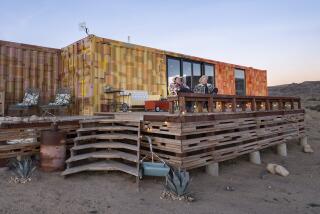Hollywood
Lisa Ferrante, who lives in Taos, N.M., works in a high-keyed Southwestern religious idiom that works best when she surrenders completely to its fierce side. Most remarkable are the skeleton woodcuts--not prints on paper but finely cut blocks of wood framed in painted boxes edged with delicate hammered tin.
In “Job,” the beleaguered figure, his gaunt black-speckled body delineated in the fine horizontal “ribbing” of the gouged-out wood, lives under a flaming peaked roof barely keeping lightning and a tornado at bay. Woodcut crucifixion images have a similar naive-but-knowing power. The linear black moire effect of sky, water and land in “El Calvario” adds a harshly romantic global vision to the ultimate scene of suffering.
Lacking such a personal and exotic style, Ferrante’s paintings tend to look more generic, sometimes even downright kitschy. “La Curandera,” the faith healer, is a black boulder of a woman with clenched hands sitting in a bare space with a pair of long-burning candles. In “Naked Crucifixion,” the silhouetted view against an evening sky seems awfully hackneyed, even with the mysterious presence of four moons.
But a fine otherworldly delicacy surfaces in “La Bruja.” A nude, antlered sorceress seen in the gray light of a clearing, she holds blood-spurting crosses in each hand for an audience of black cats. (Newspace Gallery, 5241 Melrose Ave., to July 30.)
More to Read
The biggest entertainment stories
Get our big stories about Hollywood, film, television, music, arts, culture and more right in your inbox as soon as they publish.
You may occasionally receive promotional content from the Los Angeles Times.










